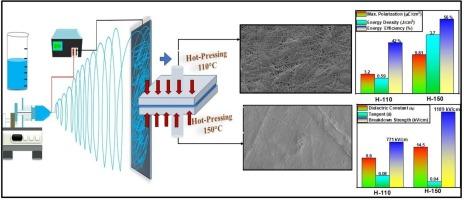Appreciable amelioration in the dielectric and energy storage behavior of the electrospun fluoropolymer PVDF-HFP thick films: Effect of hot-pressing
IF 5.4
2区 医学
Q2 MATERIALS SCIENCE, BIOMATERIALS
引用次数: 0
Abstract
Prospects of applicability of electrospun Poly(vinylidene fluoride-co-hexafluoropropylene) (PVDF-HFP) films for high energy density capacitors operable under harsh conditions (30 °C - 80 °C) has been investigated. The dielectric and energy storage behavior of structurally and morphologically characterized electrospun hot-pressed PVDF-HFP film has been thoroughly studied and analyzed in the temperature range of 30 °C - 80 °C. The pristine film, film hot-pressed at 110 °C and 150 °C are nominated as H-0, H-110 and H-150. The dielectric constant (ε) and dielectric loss (tanδ) of H-150 film at 1 kHz is found to be ∼13.4 and ∼ 0.04 respectively; whereas the respective values for H-110 films are ∼9.8 and ∼ 0.08. The dielectric properties of H-150 film are relatively more thermally stable as compared to H-110 film up to 80 °C. Discharge energy density, energy efficiency and breakdown strength for H-150 film are 3.7 J/cm3, 56 % and 1189 kV/cm respectively, which is remarkably higher as compared to H-0 with respective values as 0.128 J/cm3, 20 % and 352 kV/cm and H-110 film with respective values as 0.598 J/cm3, 42 % and 771 kV/cm. The superior dielectric properties, breakdown strength and energy storage behavior of PVDF-HFP film hot-pressed at 150 °C is attributed to the formation of a micro capacitive network caused by interfacial connectivity and alignment of the nanofibers. Hot-pressing of nanofiber polymeric films is a simple yet effective technique that could be a futuristic approach to develop dielectric films for high energy density capacitors.

电纺含氟聚合物 PVDF-HFP 厚膜的介电和储能性能明显改善:热压的影响
研究人员调查了电纺聚偏氟乙烯-六氟丙烯(PVDF-HFP)薄膜在恶劣条件(30 °C - 80 °C)下用于高能量密度电容器的应用前景。在 30 °C - 80 °C 的温度范围内,对具有结构和形态特征的电纺热压 PVDF-HFP 薄膜的介电和储能行为进行了深入研究和分析。原始薄膜、110 ℃ 和 150 ℃ 热压薄膜分别被命名为 H-0、H-110 和 H-150。在 1 kHz 频率下,H-150 薄膜的介电常数(ε)和介电损耗(tanδ)分别为 ∼ 13.4 和 ∼ 0.04;而 H-110 薄膜的介电常数(ε)和介电损耗(tanδ)分别为 ∼ 9.8 和 ∼ 0.08。与 H-110 薄膜相比,H-150 薄膜的介电性能在 80 °C 以下具有更高的热稳定性。H-150 薄膜的放电能量密度、能量效率和击穿强度分别为 3.7 J/cm3、56 % 和 1189 kV/cm,明显高于 H-0(分别为 0.128 J/cm3、20 % 和 352 kV/cm)和 H-110 薄膜(分别为 0.598 J/cm3、42 % 和 771 kV/cm)。在 150 °C 下热压的 PVDF-HFP 薄膜具有优异的介电性能、击穿强度和储能行为,这归功于纳米纤维的界面连接和排列形成了微电容网络。热压纳米纤维聚合物薄膜是一种简单而有效的技术,可作为开发高能量密度电容器介电薄膜的未来方法。
本文章由计算机程序翻译,如有差异,请以英文原文为准。
求助全文
约1分钟内获得全文
求助全文
来源期刊

ACS Biomaterials Science & Engineering
Materials Science-Biomaterials
CiteScore
10.30
自引率
3.40%
发文量
413
期刊介绍:
ACS Biomaterials Science & Engineering is the leading journal in the field of biomaterials, serving as an international forum for publishing cutting-edge research and innovative ideas on a broad range of topics:
Applications and Health – implantable tissues and devices, prosthesis, health risks, toxicology
Bio-interactions and Bio-compatibility – material-biology interactions, chemical/morphological/structural communication, mechanobiology, signaling and biological responses, immuno-engineering, calcification, coatings, corrosion and degradation of biomaterials and devices, biophysical regulation of cell functions
Characterization, Synthesis, and Modification – new biomaterials, bioinspired and biomimetic approaches to biomaterials, exploiting structural hierarchy and architectural control, combinatorial strategies for biomaterials discovery, genetic biomaterials design, synthetic biology, new composite systems, bionics, polymer synthesis
Controlled Release and Delivery Systems – biomaterial-based drug and gene delivery, bio-responsive delivery of regulatory molecules, pharmaceutical engineering
Healthcare Advances – clinical translation, regulatory issues, patient safety, emerging trends
Imaging and Diagnostics – imaging agents and probes, theranostics, biosensors, monitoring
Manufacturing and Technology – 3D printing, inks, organ-on-a-chip, bioreactor/perfusion systems, microdevices, BioMEMS, optics and electronics interfaces with biomaterials, systems integration
Modeling and Informatics Tools – scaling methods to guide biomaterial design, predictive algorithms for structure-function, biomechanics, integrating bioinformatics with biomaterials discovery, metabolomics in the context of biomaterials
Tissue Engineering and Regenerative Medicine – basic and applied studies, cell therapies, scaffolds, vascularization, bioartificial organs, transplantation and functionality, cellular agriculture
 求助内容:
求助内容: 应助结果提醒方式:
应助结果提醒方式:


